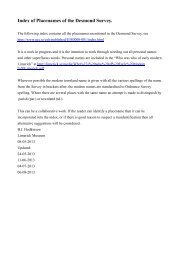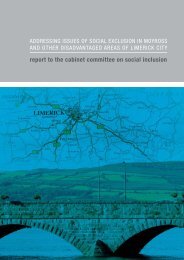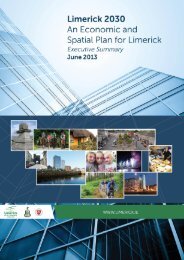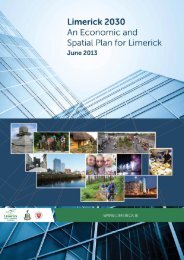An Economic and Spatial Plan for Limerick Appendices
An Economic and Spatial Plan for Limerick Appendices
An Economic and Spatial Plan for Limerick Appendices
Create successful ePaper yourself
Turn your PDF publications into a flip-book with our unique Google optimized e-Paper software.
<strong>Limerick</strong> 2030 <strong>An</strong> <strong>Economic</strong> <strong>and</strong> <strong>Spatial</strong> <strong>Plan</strong> <strong>for</strong> <strong>Limerick</strong><br />
The 18 th Century in Irel<strong>and</strong> was a period of considerable stability <strong>and</strong> economic growth which was<br />
replicated in <strong>Limerick</strong>. The City benefited from strong <strong>and</strong> stable markets in Europe <strong>and</strong> North<br />
America as it became the marketing centre <strong>for</strong> the rich agricultural counties of <strong>Limerick</strong> <strong>and</strong><br />
Tipperary <strong>and</strong> as a consequence of its successful port which allowed access to international<br />
markets.<br />
It was at this point that Edmund Sexton Pery had such a significant impact upon the City. Pery was<br />
responsible <strong>for</strong> significant expansion of the City through the creation of Newtown Pery to the west<br />
<strong>and</strong> south of Irish Town. Owning l<strong>and</strong> immediately beyond the City walls Pery obtained the right to<br />
pursue large scale building outside the City walls which began to be demolished from 1760 onwards.<br />
In keeping with Georgian style urban planning Pery put in place a grid style plan <strong>for</strong> Newtown Pery<br />
which was partially implemented between 1769 <strong>and</strong> the 1850’s. By 1874 the plan had been set aside<br />
when the idea of a major Georgian Square at Pery Square was finally ab<strong>and</strong>oned.<br />
From 1854 the Irish famine ended the most significant period in the City’s growth.<br />
The 20 th Century has seen a gradual erosion of this character through large scale shopping <strong>and</strong><br />
office development, changes of use <strong>and</strong> the general decline of the Georgian legacy as residents<br />
have left the City Centre <strong>and</strong> the impact of suburban shopping <strong>and</strong> residential development has<br />
been felt.<br />
There are few recent 21 st Century developments of significant architectural merit in the City Centre<br />
<strong>and</strong> indeed many have significantly detracted from other characters of the City Centre. This<br />
presents an added challenge to the City in the longer term.<br />
Urban Structure<br />
<strong>Limerick</strong> has the potential to be a great European City. Its most outst<strong>and</strong>ing asset is the quality of its<br />
stunning waterfront location <strong>and</strong> its remaining Medieval <strong>and</strong> Georgian street <strong>and</strong> block structure<br />
built heritage.<br />
As a consequence of its 18 th <strong>and</strong> 19 th Century expansion the City is blessed with many outst<strong>and</strong>ing<br />
samples of Georgian domestic <strong>and</strong> civic architecture <strong>and</strong> town planning. Combined with the City’s<br />
special waterfront setting this makes <strong>for</strong> a City of special character.<br />
Indeed the urban morphology of an urban grid adjoining a more organic <strong>and</strong> chaotic Medieval<br />
street structure with a strong waterfront setting is practically unique. This uniqueness is not fully<br />
appreciated, nor taken full advantage of.<br />
June 2013 68

















